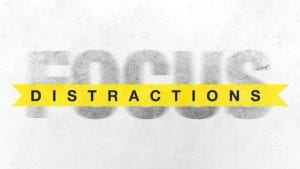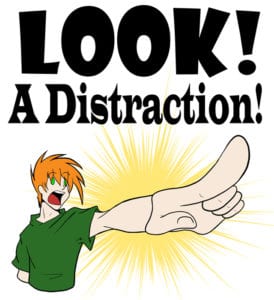
As I talk with first responders in classes about the impact of distractions and interruptions on situational awareness, I find myself often being asked: “What’s the difference?” While there are distinctly different causes for distractions and interruptions, the outcome is often very similar…a reduction in situational awareness and the potential for a catastrophic outcome. [tweet this]
A distraction is something that draws one’s attention away from what they are supposed to be paying attention to, entirely unintentionally. For example, a responder working at a scene might be distracted by a loud noise (e.g., an air horn, siren, a scream, or an explosion). This draws the attention of the responder to the source of the noise (though it doesn’t have to be a noise… it could just as easily be something visual or a smell). While the responder’s attention is focused on the sources of the distraction, however brief, attention is drawn away from what he or she was giving attention to just prior to the distraction.
An interruption is something that draws one’s attention away from what they are supposed to be paying attention to, entirely on purpose. For example, a responder working at a scene might be interrupted by someone talking to him or her, by being called on the radio or by receiving a cell phone call. The interruption draws the attention of the responder away. However brief, attention is refocused on something new.
 The reason distractions and interruptions are so dangerous for responders are multiple fold. [tweet this] First, emergency scenes are fertile ground for distractions and interruptions. There are often loud noises, bright lights, and lots of things to stimulate the visual and audible senses. Second, responders like to share information and this is often done by radio or face-to-face communications. Each interaction is, without passing judgment on how important it may be, an interruption to the receiver’s thought process.
The reason distractions and interruptions are so dangerous for responders are multiple fold. [tweet this] First, emergency scenes are fertile ground for distractions and interruptions. There are often loud noises, bright lights, and lots of things to stimulate the visual and audible senses. Second, responders like to share information and this is often done by radio or face-to-face communications. Each interaction is, without passing judgment on how important it may be, an interruption to the receiver’s thought process.
Every time a thought is disrupted by a distraction or interruption, the brain leaves one thought behind to pick up on the new one. When this happens, situational awareness is at risk because the return to the original thought may not be to the exact place where the thought was left. Or, even more dangerous, it’s possible the brain may never come back to the original thought at all, even though that original thought may have involved the performance of a critical safety task.
Chief Gasaway’s Advice
 The best way to avoid the impact of distractions and interruptions is to reduce exposure to them. If commanding this incident, this can be accomplished by being physically remote from direct contact to those stimuli that distract and interrupt. This may mean commanding from a short distance away from the action or commanding from within a vehicle.
The best way to avoid the impact of distractions and interruptions is to reduce exposure to them. If commanding this incident, this can be accomplished by being physically remote from direct contact to those stimuli that distract and interrupt. This may mean commanding from a short distance away from the action or commanding from within a vehicle.
For operational personnel, consider assigning one person to listen to one radio, versus having the entire company listen to every radio transmission and risk having the entire crew being mentally drawn off task. Remember a radio transmission is an interruption. Try to avoid having the entire company drawn off task to listen to a radio transmission that may not even pertain to their assignment. And while consideration needs to be given to avoiding tunneled senses (which is a critical barrier to situational awareness and a topic I will take on in a future article), it is important to stay focused on the task.
Action Items
 1. Describe an incident scene where you were distracted by something visual or audible. How did it impact your ability to stay focused on your task?
1. Describe an incident scene where you were distracted by something visual or audible. How did it impact your ability to stay focused on your task?
2. What are some tips and tricks you use to control distractions and interruptions while operating on stimulus-rich emergency scenes?
3. Are your commanders located remotely or in the thick of the action? What have you observed about their ability to maintain situational awareness based on where they are located?
_____________________________________________________________
The mission of Situational Awareness Matters is simple: Help first responders see the bad things coming… in time to change the outcome.
Safety begins with SA!
_____________________________________________________________
Share your comments on this article in the “Leave a Reply” box below. If you want to send me incident pictures, videos or have an idea you’d like me to research and write about, contact me. I really enjoy getting feedback and supportive messages from fellow first responders. It gives me the energy to work harder for you.
Thanks,

Email: Support@RichGasaway.com
Phone: 612-548-4424
Facebook Fan Page: www.facebook.com/SAMatters
Twitter: @SAMatters
LinkedIn: Rich Gasaway
YouTube: SAMattersTV
iTunes: SAMatters Radio

